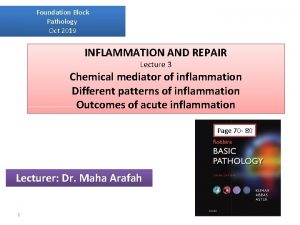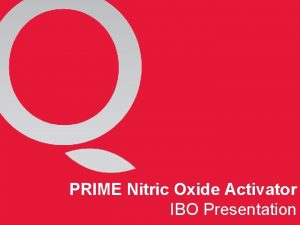Nitric Oxide Production from Synthesized Ruthenium III Porphyrins

- Slides: 1

Nitric Oxide Production from Synthesized Ruthenium (III) Porphyrins Matthew J. Ranaghan, Jeannette Suh, Stephen K. O’Shea, and Cliff J. Timpson Roger Williams University, One Old Ferry Road, Bristol, RI 02809 Abstract One of the regulatory processes of nitrite in mammalian systems is by its reaction with iron found in porphyrin systems. One important reaction is the production of an Iron (II) nitrosyl from Iron (III) and a nitrite ion. This research investigated Ru (III) porphyrin systems, as it is a possible candidate in blood substitutes and in therapeutic drugs as cofactors. The Ru (III) porphyrin base was varied between octaethylporphyrin, tetraphenylporphyrin, and saturated ring cyclam (1, 4, 8, 11 -tetraazacyclotetradecane). The addition of nitrite to varying Ru (III) macrocycles will be monitored with repetitive UV-vis spectroscopy scans in order to determine the rate of reaction for the formation of Ru(II) NO macrocycles. The varyation of the E 1/2 redox potential of the Ru (III) center is to be investigated by cyclic voltammetry and correlated to the reaction rate to elucidate the mechanism. Introduction Discussion Research of Ru porphyrins and their production of nitric oxide was investigated in order to elucidate whether the mechanism is similar to that of Fe in living organisms. Normal oxidation states for Fe are +2/+3 (unbound/bound Oxygen respectively). The dependence of NO binding to the metal center does not differ only by the metal of interest, but also relies on the exterior ligands 10 of the porphyrin system. Therefore, the macrocyclic structure was varied between octaethylporphyrin (OEP), tetraphenylporphyrin (TPP) and saturated ring cyclam (1, 4, 8, 11 tetraazacyclotetradecane). The kinetics of NO 2 - binding to the Ruthenium were studied by varying the exterior porphyrin ligands, and slight variation in the ring structure (cyclam). The results show that nitric oxide production is possible through the presence of nitrite and a triphenylphosphine (PPh 3) substrate that removes an oxygen from the activated nitrite Ruthenium complex center of the porphyrin. The Ruthenium metal is also reduced upon the formation of the nitrosyl. The proposed mechanism is reported by a correlation of the authentic Ru(II)NO macrocycle and the final spectra of the monitored reaction. Triphenylphosphine oxide (OPPh 3) was qualitatively observed by gas chromatographic methods. The mechanism of nitrite coordination and oxidation of the PPh 3 to OPPh 3 was shown to be redox dependant. The activated complex undergoes reduction from Ru. III to Ru. II corellating with the rate of nitrosyl formation. Complex Ru(TPP)a Ru(OEP)b Ru(cyclam)b Porphyrins play a vital role in the mechanism of life. A class of porphyrins (or hemes) that is utilized by multicellular organisms is found in hemoglobin and myoglobin. Both of these are used for oxygen (O 2) and carbon dioxide (CO 2) transportation throughout the body. Cytochromes are a class of monomeric active porphyrin systems involved in metabolic redox pathways, and are responsible for the generation of nitric oxide (NO) in the body. The NO molecule is a highly reactive free radical that is used for specific purposes in biological systems, such as in immune system response mechanisms, the cardiovascular and nervous system 1, as well as messenger signals in and between cells. 2 iron is found at the center of heme structures of living organisms. Ru (II) heme analogs are found to be more stable than their Fe (II) counterparts, while behaving with similar chemistry to the Fe derivatives since Ru is a chemically similar metal. 3 The importance of investigating a Ru metal center in place of an Fe center is because of the interest in whether the Ru complexes will be stable enough to be used for blood substitutes. 4 Stripping away the protein shell of Cytochromes or Hemoglobin will leave just the active metal porphyrin center. 5 Observing the subtle effects at this site will give a more intuitive and clearer perspective of the mechanism of NO generation. Here, we propose another possible source of NO that originates from nitrite (NO 2 -) interacting with the metal center of hemes. Once attached to the metal center, an oxygen atom is transferred from the molecule to a substrate molecule. Investigations of the interaction between an Fe active site with nitrite and the formation of a nitrosyl ligand have been thoroughly researched. 6 Therefore, research was focused on the investigation of the interaction of Nitrite with the Ru (II) porphyrin chloride. Methods and Materials Spectroscopic grade solvents (Aldrich, Fisher) and reagents (Aldrich, Frontier Scientific) were obtained commercially and used as supplied. The complex meso-Tetraphenylporphine (TPP) was prepared according to the procedure previously reported by Adler. 7 Purification of TPP was carried out on activated alumina (mesh 80 200) column chromatography with chloroform as the eluent. The Octaethylporphine (OEP) complex was prepared according to the procedure described by Ariel. 8 The cyclam complex was prepared according to the procedure described by Lang. 9 The Alternate TPP-NO complex was prepared in according to the synthesis described by Kadish. 6 UV-Vis spectra and kinetic data were collected on a Hewlett-Packard HP-8453 Diode Array spectrophotometer and gas chromatographic data was collected on the Perkin Elmer Sigma 300 Capillary Chromatograph. Rate (s-1) 1. 09 x 10 -5 1. 02 x 10 -5 0. 94 x 10 -5 a – in 0. 1 M TBAH/CH 2 Cl 2 E 1/2 Ru. II/III (V) 0. 21 (vs. SSCE) 0. 08 (vs. SSCE) -0. 15 (vs. NHE) b - in 0. 1 M TBAH/CH 3 CN Conclusions • Ruthenium porphyrins are able to bind and produce Nitric Oxide through the aid of a substrate. • Nitric Oxide is produced by the reduction of an oxygen molecule to a triphenylphosphine substrate. • Exterior porphyrin ligands are important for increasing or decreasing the overall affinity of Nitrite to the Ruthenium center and the kinetics of the reaction. • Reasonable mechanism since nitrite is heavily present in the environment. • The proposed mechanism of nitrite coordination and the oxidation of PPh 3 is shown to be qualitatively correct from the presence of OPPh 3 and the relationships between the spectra. References 1. 2. 3. 4. Lorkovic I. M. ; Ford, P. C. Inorg Chem. 1998, 38, 1467 -1473. Stryer, L. 1995. Biochemistry (4 th ed. ). Freeman. pg. 732. Miranda, K. M. ; Bu, X. ; Lorkovic, I. ; Ford, P. C. Inorg. Chem. 1997, 36, 4838 -4848. (a) Information obtained in a private conversation with Dr. O’Shea (November 14, 2002) (b) Zampieri, R. C. ; Von Poelhsitz, G. ; Batista, A. A. ; Nascimento, O. R. ; Ellena, J. ; Castellano, E. E. J. Inorg. Biochem. 2002, 92, 82 -88. 5. O’Shea, S. K. ; Wang, W. ; Wade, R. S. ; Castro, C. E. J. Org. Chem. 1996, 61, 6388 -6395. 6. Kadish, K. M. ; Adamian V. A. ; Van Caemelbecke E. ; Tan, Z. ; Tagliatesta, P. ; Bianco, P. ; Boschi, T. ; Yi, G. B. ; Khan, M. A. Richter-Addo, G. B. Inorg. Chem. 1996, 35, 1343 -1348. 7. Alder, A. D. ; Longo, F. R. ; Finarelli, J. D. ; Goldmacher, J. ; Assour, J. ; Korsakoff, L. J. Org. Chem. 1967, 32, 472. 8. Ariel, S. ; Dolphin, D. ; Domazetis, G. ; James, B. R. ; Leung, T. W. ; Rettig, S. J. ; Trotter, J. ; Williams, G. M. Can. J. Chem 1984, 62, 755 -762. 9. Lang, D. R. ; Davis, J. A. ; Lopes, L. ; Ferro, A. ; Vasconcellos, L. ; Franco, D. ; Tfouni, E. ; Weiraszko, A. ; Clarke, M. Inorg. Chem. 2000, 39, 2294 -2300. 10. Zavarine, I. S. ; Kini, A. D. ; Morimoto, B. H. ; Kubiak, C. P. J. Phys. Chem 1998, 102, 7287 -7297. Acknowledgments This work was supported by the Office of Academic Affairs Grants, the Undergraduate Research Program at Roger Williams University, and the Rhode Island NIH Brin grant. Thanks to Meghan Gordon and Christopher Mucci for their help. www. rwu. edu

